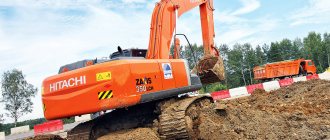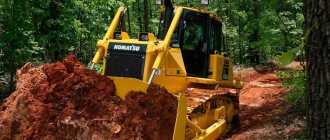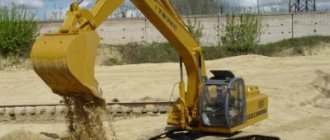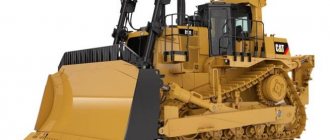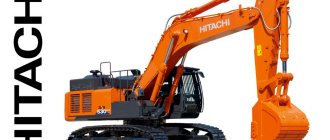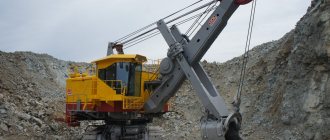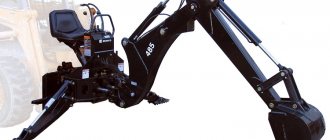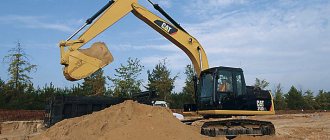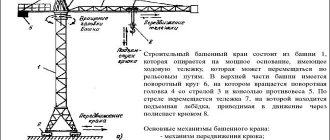In terms of construction equipment sales, excavators are second only to compact machines like skid steer loaders. In this article we will look at middle-class excavators, to which experts classify machines with an operating weight from 8 to 25–30 tons. This market segment offers many models, varying in functionality and prices - to suit any needs and wallets of customers.
The market for crawler excavators weighing between 8 and 30 tonnes has been growing over the past two years and is showing a clear upward trend, especially among machines weighing 12 to 16 tonnes. In the residential construction industry, due to their wide functionality and versatility, hydraulic excavators are often the first machines to arrive on construction sites for initial clearing using a bulldozer blade, arrangement of construction sites, laying underground communications, excavation for foundations, backfilling of trenches and pits, finishing site planning and being the last to leave it, after large-scale landscaping at the end of construction, which previously was always carried out only by bulldozers. Small construction firms choose smaller machines for excavation work instead of heavy excavators, so as not to use heavy trailers and tractors and not have to deal with obtaining transportation permits, since excavators of this class can be transported on public roads without issuing special permits.
Small-sized excavators from the specified range are popular with utility services and specialized companies - from those involved in the arrangement of sewerage structures to those building swimming pools in private cottages, since they can lift almost any components of these structures and easily remove soil to a depth of 2500–3000 mm. Such machines are in great demand among companies that rent out equipment, and most of all excavators weighing about 14 tons.
Improving machine design
All major hydraulic excavator manufacturers are improving their machines in an effort to gain a competitive edge. Over the past 10 years, the most significant changes have occurred in the performance and fuel efficiency, emission control devices and safety systems of excavators, and their functionality has increased. Each new generation model is usually more powerful than the previous one. Construction work is becoming more complex and varied, therefore, the more universal the excavator is, the more convenient it is for builders - it will be possible to do without other types of machines, and the economic effect of operating the equipment will increase.
Automatic leveling systems are also an effective modern means of increasing the overall productivity and efficiency of a machine. They monitor the position of the work tool (bucket) in real time, helping the operator and increasing the accuracy of work.
For modern mid-class excavators, a number of tracked undercarriage options are offered, in particular rubber tracks for working on hard surfaces. Some models can even be equipped with rubber wheels instead of steel tracks! With wheels, an excavator can move faster under its own power from one construction site to another.
Knowing the habits of builders, some manufacturers have begun to include reinforced booms as standard to prevent them from breaking if buckets that are too large are used. Nevertheless, booms on excavators often break, even reinforced ones. This occurs due to incorrect actions of operators. Perhaps the biggest mistake operators make is when they try to push and pull loads with the sideways movement of the boom, a motion that eventually causes the boom and its arms to break. The boom is designed and intended to apply forces in the longitudinal direction: digging and carrying loads.
Some models in the range we are interested in are now equipped with a swing arm, which was usually equipped with more compact excavators. The rotating boom allows you to position the machine and work equipment so that its productivity is maximized.
Additional hydraulic circuits simplify and increase the efficiency of using replaceable attachments on modern excavators. The machines are equipped with three independently functioning hydraulic circuits: for the working equipment - a primary circuit with a high flow rate, a secondary auxiliary circuit and a circuit for the quick coupling adapter, since the adapters are most often hydraulically driven. Advanced electronic hydraulic control systems quickly adjust the varying pressures and flow rates required for a wide range of different attachments. Such systems reduce machine downtime and increase the productivity of replaceable equipment.
Excavators now also come standard with a dozer blade (which can be a large, six-way hydraulic unit) for backfilling trenches. In addition, the blade serves as an additional support for the machine, due to which the digging depth even increases, for example, on one of the models, allegedly by 200 mm.
Tools
The design of crawler excavators allows them to be equipped with various types of removable equipment. Instead of a standard bucket, the operator can independently install any necessary tools on the rotary handle. Most often, hydraulic hammers, grab jaws, ripper teeth, hydraulic drills, log grabbers, and hydraulic shears are used to equip crawler excavators. Also, pile driver masts and various hooks are often used as a replacement for a bucket. All this allows us to significantly expand the list of tasks that can be solved using just one piece of equipment.
“Zero” and shortened rear overhang
Due to the larger working radius of mid-range excavators, they require a large counterweight, which usually protrudes from the rear of the superstructure. But when working in tight spaces, the protruding rear end gets in the way of the excavator. Therefore, models with reduced or “zero” rear overhang are popular, for example, with utilities and road services, and manufacturers have taken this need into account: a number of companies have released models of mid-range excavators with “zero” or reduced rear overhang (for example, only 100 mm), which Previously they were found only among mini-excavators. Designers of new models of middle-class excavators manage to place a heavy counterweight on the machine, while reducing the rear overhang. Such machines can operate in one lane of the road without blocking adjacent ones, and the operator can concentrate on bucket work without worrying about the rear end colliding with an obstacle.
Models with zero and reduced rear overhang in the class under consideration do not yet make up the majority of sales, but their share is growing rapidly, and in the range of crawler excavators weighing 12–16 tons, models with minimal and “zero” rear overhang already predominate.
Models weighing about 8.5 tons almost always have a “zero” or shortened rear overhang and a rotating boom, which, in combination with a bucket rotator, allows you to remove soil with “jewelry” precision in extremely cramped conditions. The pivoting boom is an advantage that attracts buyers to these models. As a rule, such machines are equipped as standard with additional hydraulic circuits, the flow rate of which is 50% of the capacity in the main hydraulic circuit. They are widely used for mounting equipment such as thumb grips. Thanks to the presence of an additional circuit, the gripper is always ready for use, and the main hydraulic circuit remains free for the installation of tools such as vibrating plates and hydraulic drills, which require high hydraulic performance. In addition, these excavators can be equipped with quite powerful hydraulic hammers, large buckets and grips, with which they can successfully carry out work on demolishing buildings and processing construction waste.
Models weighing about 8.5 tons are available in the lineups of many manufacturers, often after this model there is a “gap” to models weighing about 13.5 tons. One of the main advantages that attracts consumer interest in these machines is the size of their cabins. This, of course, is not the cabin of a full-size car, but it is very close to it, at least in length, and the new models have even wider cabins. The cabs feature modern seats and position-adjustable controls. The engine power of such machines is usually 55–65 hp, and the digging depth is on average about 4300 mm, although a number of models have a digging depth exceeding 4600 mm. Rubber tracks are usually standard, but steel tracks are available as an option on many models. Typically, a blade is also installed as standard or upon request.
Models with “zero” rear overhang are very versatile, while the overhang is minimally reduced. Some of these models offer the option of larger counterweights that increase machine stability and lifting capacity (by approximately 15%) and are especially useful on machines equipped with a thumb grip on the boom. The additional counterweight slightly increases the rear reach of the machine, by approximately 150–230 mm.
Application area
The crawler excavator is indispensable for the construction industry. It is also actively used in the logging, agricultural, manufacturing and municipal sectors. A crawler excavator is in demand when carrying out road construction or emergency rescue work. Functional and design features, as well as a variety of additional equipment, allow this equipment to perform operations such as:
- development of pits for the construction of permanent buildings,
- arrangement of trenches for pipelines and communications,
- construction of ditches and embankments near roads,
- development of rocky soils,
- loosening frozen or particularly hard soil,
- cleaning water bodies from silt and other contaminants,
- demolition of buildings and other structures,
- loading and unloading of bulk materials,
- moving metal structures.
Replacement tools for excavators
Ten years ago, construction jobs used barely half the attachments used today, and the number of attachments continues to grow. The most popular among both builders and utilities, not counting buckets, are thumb grippers and hydraulic hammers, vibratory compactors, hydraulic shears for demolition of buildings and scrap metal, electromagnets, hydraulic drills, branch choppers, brush cutters and grippers for landscaping work, dumps , guardrail lifting grips and a comprehensive range of buckets. The thumb allows the excavator to grasp a variety of objects, especially useful for transporting pipes and other components on a construction site. Hydraulic hammers are especially in demand in areas where large stones and rocks are encountered during excavation work.
The Japanese company Kobelco is a “classic” manufacturer of excavators, whose products have great authority in the international market. FKR Machinery LLC is the only authorized distributor of Kobelco Construction Machinery Co. Ltd in Russia. Kobelco excavators are optimally adapted to Russian operating conditions: long periods of low air temperatures and frequent use of low-quality fuel. The new eighth series vehicles are distinguished by significantly increased fuel efficiency and the degree of fuel filtration; a number of systems and components have also been improved. FKR offers Russian consumers models of Kobelco excavators weighing up to 30 tons – SK200-8/SK210LC-8 and SK250-8/SK260LC-8.
The machines are equipped with a comfortable cabin with air conditioning, in which the operator is provided with excellent visibility through reinforced tinted windows, on hydraulic supports, thanks to which the level of vibration has decreased by 2 times compared to the previous generation machines, and legroom has been increased. Control is carried out by levers and pedals. The effort of moving the levers decreased by 10%. There is a self-diagnosis function.
Electronically controlled direct injection engines. After some time of idling the engine, the electronic control system reduces the speed and then turns off the engine. Two operating modes are provided: standard S, in which fuel consumption is reduced by up to 20% compared to the previous generation of excavators, while maintaining the volume of work performed, and heavy work mode H, in which the volume of work performed increases by 8% compared to previous models, but fuel consumption remains the same. The fuel filter is triple: two preliminary ones with sedimentation tanks and a main one. Thanks to improved fuel efficiency and increased fuel tank capacity, the operating time of excavators without refueling has increased by 30–70%.
The hydraulic system has been improved, pressure losses have been reduced, and there is a new highly efficient hydraulic pump. Oil life is 5000 operating hours, filter replacement interval is 1000 operating hours. As an option, operating modes for the N and B attachments - crusher and hydraulic shears - are offered; using a switch, the operator can choose from three hydraulic circuits of the replaceable equipment.
The strength of the boom and arm elements has increased. The torque of the travel mechanisms has been increased by 8–16%, and the turning speed has increased by 11%.
Performance characteristics of Kobelco excavators
| Parameter | SK200-8/ SK210LC-8 | SK250-8/ SK260LC-8 |
| Operating weight, kg | 20 400/ 20 900 | 24 600/ 25 200 |
| Engine power, kW | 118 | 137 |
| Bucket capacity, m3 | 0,8–1,3 | 0,81–1,4 |
| Bucket cutting force, normal/reinforced mode, kN | 143/ 157 | 170/ 187 |
| Travel speed, km/h | 6,0/ 3,6 | 5,8/ 3,6 |
The invention of quick-release coupling adapters has enormously expanded the scope of application of replaceable attachments. The ability to quickly replace one tool with another directly during work has radically changed the entire technology of using an excavator. However, it should be taken into account that when installing an adapter, the working radius of the bucket increases and the payload capacity and digging force of the excavator decrease. For example, by increasing the radius by just 200 mm, the penetration force of the bucket can decrease by 10%.
Classification
Modern models of crawler excavators have quite a lot of differences, although the main components are almost identical. The classification of equipment is carried out according to the following criteria.
By number of buckets:
- single-bucket – universal, suitable for work related to loading materials and digging soil;
- multi-bucket - specialized, used primarily for digging trenches and pits.
By engine type:
- electric – suitable for working in tunnels and other enclosed spaces;
- diesel - has more power and is used in open areas.
By drive of the working body:
- hydraulic – ensures the execution of two movements at once (digging, turning);
- mechanical – simple and reliable to use.
According to the shape of the bucket:
- straight shovel – capable of turning around when taking rock;
- a construction bucket is more spacious and durable.
By chassis type:
- normal – suitable for standard operating conditions;
- widened-elongated – ensures stability and off-road maneuverability.
Bucket selection
It is very important to choose the right bucket for a specific job. Sometimes construction vehicles go to a site with a single bucket, pinned in the eyes, and this bucket is used for all excavation work, because the owner of the excavator believes that there is no point in spending a lot of time and effort on dismantling and installing buckets of a more suitable width and that the more install a bucket, the greater the excavator's performance will be. In reality, an oversized bucket acts on a machine like an anchor on a boat, increasing cycle times and reducing productivity. If a larger than permissible bucket is installed on the excavator, the stability of the excavator will deteriorate, and the wear of machine parts will occur faster, and their service life will be reduced. When excavating with a bucket that is wider than necessary, productivity decreases and the volume of soil increases, which then needs to be poured back into the trench. An excavator with the right size bucket will work faster, be more fuel efficient, be easier for the operator to operate, and result in higher productivity. In order for owners to correctly select buckets and other hydromechanical tools, some manufacturers place special tables in the operating instructions for excavators.
Sometimes companies, wanting to save money, purchase cheap and low-quality equipment, but it turns out that it breaks down very quickly. Without trying to save money, choose reliable suppliers of quality equipment. You need to choose a company that can supply not only buckets, but also other equipment and tools necessary for the job, as well as provide the necessary repairs and spare parts. It's always easier to deal with one supplier. It is important to ensure that the supplier and equipment manufacturer have a good reputation. This can be done by talking with the company's customers and equipment users. You should try to find as much information about the supplier on the Internet as possible.
Some companies prefer used equipment. However, we must keep in mind that its performance characteristics will no longer be the same as those of the new one. When purchasing such equipment, you should check it very carefully.
Volvo Construction Equipment has recently launched the new Volvo EC170D crawler excavator on the Russian market, designed to perform a wide range of work - from residential construction to quarries. One of its main advantages is its low weight and size, thanks to which transporting the machine on public roads is not difficult.
The cabin is comfortable, with a liquid crystal control display, climate control system, narrow pillars and a large glass area provide excellent visibility. The electronic control system allows you to save up to 20 hydraulic system settings for various attachments. The excavator is equipped with a powerful Volvo D4 engine with Eco mode, which improves fuel efficiency. The boom and handle are made of high-strength steel and are reinforced. By optimizing the geometry of these components, digging forces are increased. Upon request, additional reinforcing plates can be welded onto the inside of the boom and handle. X-shaped frame made of high-strength steel. There are five track width options and two track length options.
In addition to this new product, Volvo CE offers a range of medium-class crawler excavators of the same D series: mod. EC220D, EC250D and EC300D, all of them are universally used, for work in both quarries and construction. The Volvo Care Cab provides the operator with a comfortable and safe working environment. There is a liquid crystal control display. The machines are equipped with new generation Volvo diesel engines with an Eco mode and an optional engine shutdown function if the machine is not running. Electronic hydraulic control improves controllability and reduces cycle times and fuel consumption. The overall reduction in fuel consumption for D series vehicles compared to previous models is 7–10%. The arrows and handles are reinforced. For ease of maintenance, machine system filters and lubrication points are collected in groups.
Technical characteristics of the Volvo EC170D excavator
| Operating weight, kg | 16 260–17 440 |
| Engine power, kW | 90 |
| Bucket capacity, m3 | 0,84 |
| Unloading height, mm | 6107–6438 |
| Recess depth, mm | 5437–6438 |
| Breakout force on the bucket, kN | 101,5–121,9 |
| Travel speed, km/h | 3,1/ 5,6 |
Specifications
Each type of crawler excavator has a standard set of components: a running frame, a rotating platform, a cabin and a working unit with a handle and a bucket. Moreover, the models have special technical characteristics and functionality. In order for the equipment to be ideally suited to specific tasks, it is necessary to take into account such parameters as:
- dimensions,
- useful power,
- movement speed,
- total weight,
- type of tracked chassis,
- bucket design and capacity.
Maintenance is easier
Manufacturers unanimously declare: the trouble with almost all owners and operators of excavators is that they chronically violate the timing and scope of technical maintenance (MOT) of the machines. Negligence in performing regular maintenance continues to be one of the main problems in the operation of modern excavators. This applies to any maintenance work: from injecting grease points to changing oils and filters. But engines of Tier 4 Interim and Final environmental classes are technically more complex compared to their predecessors and even more so require regular maintenance. Only if the maintenance schedule is carefully followed will their power and fuel efficiency be at maximum levels.
In the latest models of excavators, developers have tried to increase the frequency of maintenance, hoping that at least due to this the equipment will be serviced in a timely manner. The developers of the new models also tried to make maintenance as easy as possible for owners.
Firstly, on new models of excavators it has become easier to check the condition of technical fluids, filters and breathers: large service hatches have appeared in the design of modern excavators, by opening which the operator can easily check the level of technical fluid with a measuring rod and add liquid to the filler neck. Spin-on engine and hydraulic filters have become more available. The drain plugs are also conveniently located; the risk of spilling liquid on the ground is minimal.
Secondly, to help excavator owners, various service programs and services are being introduced, which are provided by dealer networks of manufacturers. Dealers offer customers extended maintenance programs that proactively replace parts and assemblies before they can fail and adjust systems before they become seriously damaged.
Finally, the excavator's on-board electronic control system reminds operators when their next maintenance is due. If the control system is connected to a telematics system, then the state of the machine’s units and systems is monitored via GLONASS/GPS, and the data is sent to a central computer in the office of the owner company. This is especially important for large companies that include a whole fleet of machines. From a single center, company management can control when maintenance is due for each machine and which components are out of order.
Features of the structure of the tracked undercarriage
Excavator tracks allow them to move confidently on any type of soil: loose, viscous, weak, marshy. They actually make special equipment all-season and universal for any region, thanks to which it effectively replaces other types of transport, the chassis of which is not capable of moving on extreme off-road conditions. At the same time, the tracked undercarriage is a complex system, including numerous units and components. The main mechanisms ensuring its operation are:
- drive sprocket - drives the belt;
- sloth – regulates the degree of tension of the caterpillar track;
- belt - a prefabricated element with tracks, lugs and shoes on a chain base;
- support roller - a cylindrical element that functions like wheels;
- support roller - a cylindrical product that prevents the belt from sagging in the upper part;
- chain - the main element of the track on which shoes and other parts are attached;
- bolts and nuts – secure the tracks to the chain.
During the operation of special equipment, some elements wear out quickly, while others retain their functionality longer. In any case, the owner needs to pay special attention to chassis maintenance.
Excavator selection
And finally, some recommendations on how to approach the choice of an excavator. First of all, you need to decide what size excavator you need: in terms of operating weight, digging depth, unloading height, load capacity, whether the machine should have zero rear overhang, or whether you will be satisfied with a machine with a normal overhang. You should not sacrifice power, breakout force, or other performance characteristics in order to save some money when purchasing a machine. Profit from operating a machine depends on its performance, especially if you need to meet tight deadlines while fulfilling contracts.
To maximize machine utilization, the attachment's capabilities must cover at least 85-90% of the work (that an excavator can handle) required on your construction site.
Pay attention to the degree of comfort of working conditions, the quality of visibility, the dynamism and accuracy of movements of the excavator equipment, fuel efficiency and how easy it is to perform regular maintenance.
You should take into account the reputation of cars of this brand for reliability and durability. Buy high-quality equipment (since machine downtime and repairs will quickly “eat up” everything you save on purchase) from authorized dealers who can quickly provide your equipment with high-quality service and a supply of spare parts.
Advantages
The tracked chassis and other design features give special equipment of this type numerous advantages and make it an absolute leader in its segment.
- Increased cross-country ability. The equipment demonstrates stability when moving through rural areas, dirt roads, forest clearings and off-road conditions.
- Maneuverability. Crawler excavators can be deployed anywhere and can also move the working tool with a 360° rotation.
- Reliability . The machines withstand harsh climatic conditions and operate efficiently even under heavy loads.
- Versatility. The variety of attachments allows the equipment to perform different types of tasks - from digging trenches to loading materials.
- Sustainability . Tracked vehicles easily overcome difficult terrain, climbing the steepest slopes, and are reliably protected from tipping over.
